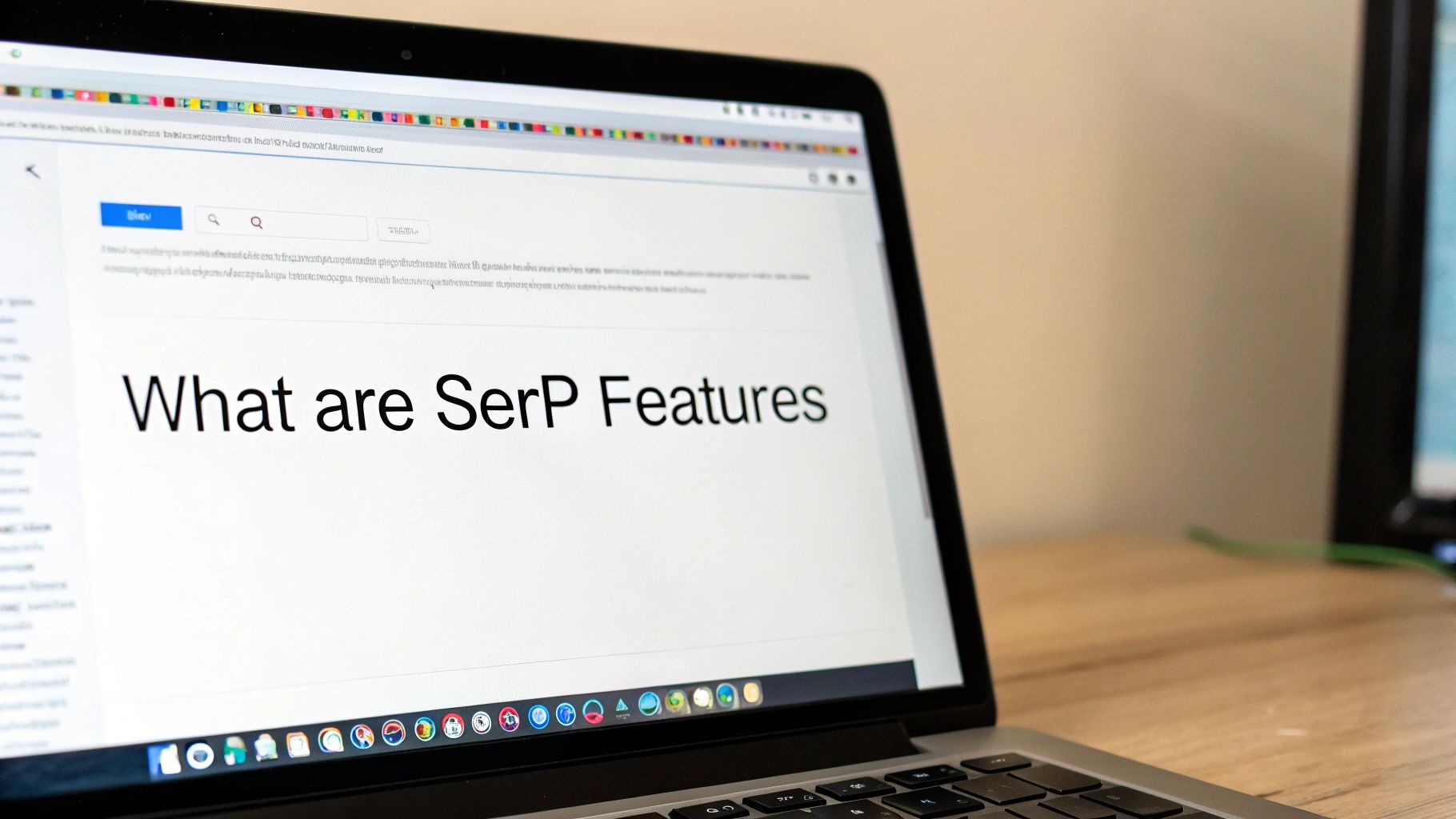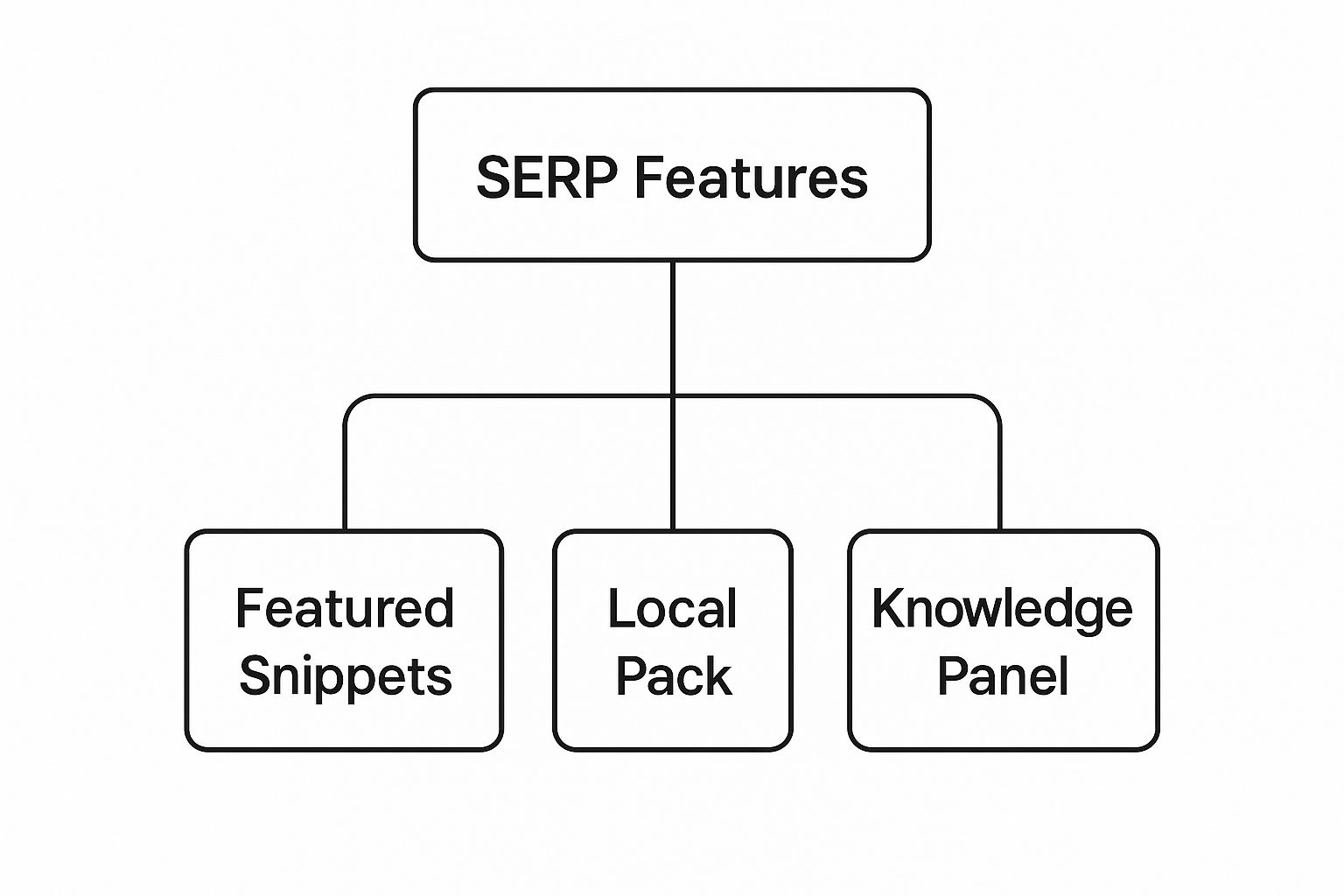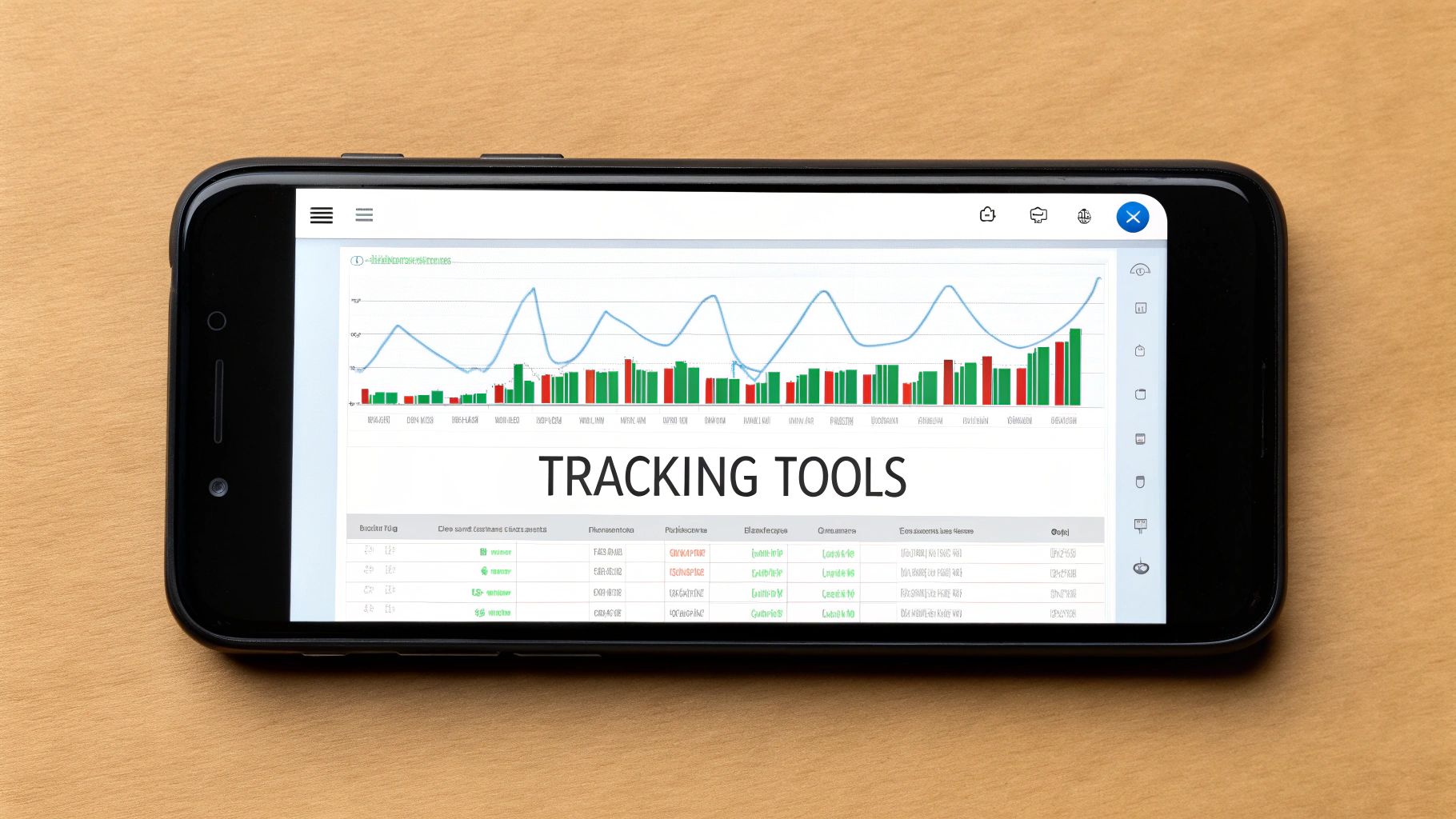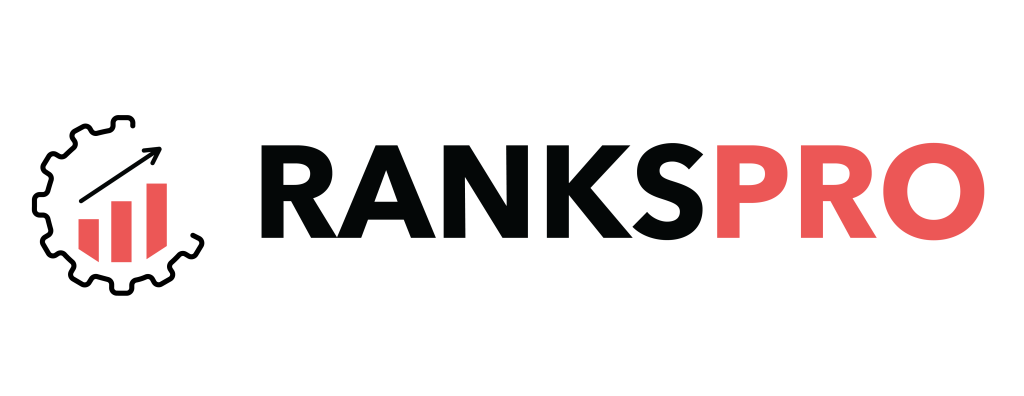Long gone are the days when Google’s search results were just a simple list of ten blue links. Today, a search engine results page (SERP) is a dynamic, interactive space filled with what we call SERP features. These are any results that aren't a traditional website link, designed to give you direct answers and information right on the page.
Think of elements like quick answer boxes, carousels of videos, or packs of images. They’re all SERP features.
Beyond the Blue Links: Unpacking Modern SERPs

Google's search page has transformed from a basic web directory into a sophisticated answer engine. It’s no longer just pointing you to other websites; it’s trying to solve your query on the spot. This is all thanks to the strategic use of SERP features—diverse content formats that pull information directly onto the results page.
From Knowledge Panels that give you a snapshot of a company to Video Carousels showcasing relevant clips, these features are all about improving the user experience. They make finding information faster, more visual, and more engaging. For anyone doing business online, this change is a pretty big deal.
A New Battleground for Visibility
Years ago, SEO was a straightforward race to the #1 spot. Now, the game has completely changed. SERP features often dominate the top of the page, appearing above the traditional organic results. This creates a brand-new, highly valuable piece of digital real estate that marketers are scrambling to win. It's where the real fight for a searcher's attention now happens.
Think of the modern SERP as a bustling city square. The classic blue links are the quiet side streets, but the SERP features are the flashy billboards and eye-catching storefronts in the main plaza. If you can secure a spot there, you're guaranteed to be seen first.
Winning these placements can be the difference between driving a flood of traffic and getting completely overlooked. It's shifted SEO from a simple ranking game to a far more strategic pursuit of attention and authority. Using a tool like RanksPro.io to see which SERP features pop up for your keywords isn't just a nice-to-have anymore; it’s fundamental to a solid strategy. For example, a quick analysis in RanksPro.io might reveal that 80% of your target keywords trigger a "People Also Ask" box, signaling a clear opportunity to structure your content around questions. By analyzing the SERP, you can spot golden opportunities your competitors are completely missing.
Understanding Position Zero
One of the most powerful SERP features is the Featured Snippet. It’s that special box at the very top that directly answers your question. It's so prominent, in fact, that SEO pros often call it “Position Zero.” Earning this spot means you can effectively leapfrog all your competitors, even those who rank higher in the standard blue links.
The data backs up its value. According to a study by Ahrefs, the Featured Snippet can steal clicks even from the #1 organic result, with some data suggesting that it can receive over 8% of all clicks. When you consider that a whopping 75% of users never even bother scrolling past the first page, you can see how securing a Featured Snippet can dramatically boost your visibility and traffic. You can dig deeper into how search page position impacts clicks on Protofuse.com.
This really highlights the double-edged sword of SERP features. They represent a massive opportunity to funnel engaged, high-intent traffic to your site. But they’re also a major threat if a competitor grabs them first, essentially stealing your potential clicks. To succeed in modern SEO, understanding and optimizing for these elements isn't optional—it's essential.
The Most Valuable SERP Features to Target
Trying to figure out which SERP features to chase can feel a bit overwhelming. With so many options, it's easy to get lost. The truth is, not every feature is a golden ticket, and what works wonders for one business might be a total waste of time for another. The real value depends entirely on your goals and the kinds of keywords you’re trying to rank for.
To get a handle on it all, it helps to think of these features in a few practical groups. Some are all about adding a little visual spice to your regular search results, while others completely take over the screen for local searches. Then you have the ones that directly answer a searcher's follow-up questions. Nailing down these categories is the first step to building an SEO strategy that actually gets results.
Visual and Informational Rich Results
Let's start with what most people call Rich Results. These are the enhancements that make a standard blue link look so much better. They pop up when you give Google a helping hand by adding structured data (or Schema markup) to your site's code. This extra code gives Google context about what your page is about, and in return, it rewards you with a more eye-catching and clickable listing.
A few key examples you’ve definitely seen are:
- Review Snippets: Those little gold stars that show up right under a URL. They provide instant social proof. Seeing a 4.8-star rating can be the single thing that convinces someone to click your link over a competitor's. A BrightLocal study found that 77% of consumers 'always' or 'regularly' read reviews when browsing for local businesses.
- FAQ Snippets: This feature adds a neat, expandable list of common questions and their answers right below your main link. It’s a fantastic way to answer multiple questions at once and simply take up more prime real estate on the results page.
- Recipe Cards: If you’re a food blogger, these are an absolute must. They display a photo, cook time, calorie counts, and ratings, making your recipe look far more enticing than a plain text result.
This image gives you a sense of the hierarchy for some of the most common SERP features.

You can see how different features are built for different jobs—from the direct answer in a Featured Snippet to the brand overview in a Knowledge Panel.
Dominating with Knowledge Graph Features
Next up are the features powered by Google's Knowledge Graph. Think of the Knowledge Graph as Google’s massive encyclopedia of "things"—people, places, brands, and concepts. When a search is clearly about one of these entities, Google pulls from its encyclopedia to build prominent info boxes.
Earning these SERP features is less about tweaking one page and more about managing your brand's reputation across the entire web. Consistency is everything.
The two heavy-hitters here are:
- Knowledge Panels: This is the big box that appears on the right side of the screen on desktop for branded searches (like "RanksPro.io"). It's basically your digital business card, showing off your logo, website, social links, and other key info. It's a powerful signal of authority.
- Local Pack: For anyone with a physical location or local service area, this is the holy grail. It’s the map and three business listings that appear for searches like "SEO agency near me." Getting into the Local Pack is non-negotiable for driving local foot traffic and calls, with research showing that nearly 46% of all Google searches are for local information.
Capturing Curiosity with Interactive Elements
Finally, we have the interactive features. These are designed to predict and answer a user’s very next question, keeping them on the search results page. To win these spots, your content needs to be incredibly direct, well-organized, and laser-focused on the questions real people are asking.
The People Also Ask (PAA) box is a perfect example. It's that accordion-style list of related questions that expands to show a short answer and a link to the source. Landing a PAA spot not only sends you traffic but also positions your site as a go-to resource on the topic.
A solid keyword research process is absolutely fundamental here, as it uncovers the exact questions your audience is typing into Google. Once you know which features are showing up for your target keywords, you can build a strategy that aligns perfectly with your business goals.
Why Winning SERP Features Drives Business Growth

Landing a spot in a SERP feature is far more than just an SEO ego boost—it's a direct line to real, measurable business growth. Here's a simple way to think about it: a standard blue link is like having a shop tucked away on a side street. Earning a SERP feature, on the other hand, is like getting the main display window on the busiest avenue in town. You're not just visible; you're unavoidable.
This prime real estate gives you an incredible boost in visibility, instantly setting your brand apart from the crowd. When you command the top of the search page, you're the first thing a user sees, and you get to shape their entire impression.
The Clear Advantage of Higher Click-Through Rates
The most immediate and obvious benefit of winning a SERP feature is the jump in your click-through rate (CTR). Time and again, the data shows that features like Featured Snippets and Rich Results blow traditional organic links out of the water.
A standard link might pull in a decent CTR, but owning the Featured Snippet at "Position Zero" can siphon off a huge chunk of all clicks for that search. Some studies have found this can lead to an increase of over 30%. We’re not talking about a small bump here; this is a game-changing lift in traffic from a keyword you were already targeting.
This gap in performance shines a light on a massive business opportunity. If you use a tool like the RanksPro.io SERP Feature Tracker and see a competitor owns the snippet for your top keyword, you've just identified a clear path to capturing that revenue. For instance, a small e-commerce site might find that a competitor holds the "Review Snippet" for their top-selling product. Winning that feature could directly translate to a double-digit increase in clicks and sales.
Securing a SERP feature is one of the fastest ways to leapfrog a competitor without having to claw your way up the traditional ranking ladder. It’s a strategic shortcut to the top of the page, where the majority of clicks happen.
Ultimately, a higher CTR translates directly into more leads, more sales, and a healthier bottom line. It’s what turns your SEO work from a background task into a core driver of business growth.
Building Unshakable Brand Authority
Beyond the instant traffic wins, consistently appearing in SERP features is a powerful way to build brand authority and trust. Think about it: when Google itself selects your content to provide a direct answer, it's a massive vote of confidence. It tells users that your site is credible, relevant, and trustworthy.
Every time you show up in a feature, you're doing a few key things for your brand:
- Establishing Expertise: You become the go-to source for important questions in your field.
- Building Trust: Users see your brand essentially endorsed by Google, giving you instant credibility.
- Increasing Recall: Being seen over and over makes your brand memorable when it comes time to buy.
This isn't just about a single win. Using a tool like RanksPro.io, you can track your SERP feature ownership across hundreds of keywords. Watching that presence grow over time is a tangible measure of your rising authority in the market. A practical example would be a SaaS company tracking 50 keywords related to their software. Seeing their SERP feature ownership grow from 5% to 25% over a quarter is a hard metric that proves their content strategy is successfully building authority.
Preparing for the Future of Search
Optimizing for SERP features isn’t just about winning today; it’s about future-proofing your business. The way people search is evolving, with voice assistants and AI-driven answers becoming the norm.
So, where do you think voice assistants like Alexa and Google Assistant get their answers? They pull them directly from SERP features, especially Featured Snippets. If your content is the source for that snippet, it's also likely to be the spoken answer on millions of smart speakers and devices. According to industry statistics, about 70% of answers from voice assistants are pulled from a SERP feature.
This makes your SERP feature strategy a vital part of your voice search optimization plan. By focusing on creating clear, direct, and question-answering content, you're not just grabbing valuable screen space—you're positioning your brand to lead in the next wave of search. Every feature you win today is an investment in your visibility tomorrow.
How to Optimize Your Content to Win SERP Features
Knowing what SERP features are is one thing. Actually capturing them is another game entirely—this is where your strategy gets put to the test. It takes more than just writing great content; you need a deliberate, almost surgical approach that aligns every piece of your page with what Google wants to see.
Think of it like building with LEGOs. You can have the best bricks in the world (your content), but if you don't follow the instructions (optimization best practices), you're never going to end up with the starship on the box (the SERP feature). Consider this your instruction manual for building content that Google can't help but feature.
Target Snippets with Question-Based Headings
The most direct route to winning Featured Snippets and filling those People Also Ask (PAA) boxes is to think like your audience and structure your content around their questions. These features exist to deliver quick, authoritative answers, and your job is to make your content the clearest and most concise source available.
A simple but powerful tactic is to frame your H2 and H3 subheadings as questions. So, instead of a vague heading like "Choosing a Bike," get specific with "How Do You Choose the Right Bike Size?" This instantly signals to Google that you’re about to provide a direct answer to a common search query.
Right below that question-based heading, give the answer. Do it immediately and keep it brief, ideally in a single, well-written paragraph. The data shows the sweet spot for a text snippet is between 40-60 words, so conciseness is key. You can always expand on the topic further down the page.
For example, if you use a keyword tool within RanksPro.io and discover "what are SERP features?" has a monthly search volume of 2,000 and a prominent PAA box, you'd be smart to create a specific H3 in your article titled "What Are the Most Common SERP Features?" and then immediately follow it with a clear, bulleted list. This kind of structure makes it incredibly easy for Google to lift your content for a snippet.
Implement Schema Markup for Rich Results
While a smart content structure is your ticket for snippets, winning Rich Results—like those eye-catching review stars, FAQ dropdowns, and recipe cards—requires a bit of technical work. This is where Schema markup comes in.
Schema is essentially a second language you add to your website's code. It doesn't change what users see, but it gives search engines a much deeper understanding of what your content is about. It’s like adding labels to items in a grocery store. Without them, a shopper (or Google) just sees shelves of products. With them, they know exactly what each item is, its price, and its key features.
Here's how you can use it for different SERP features:
- For Reviews: Use
Reviewschema to mark up product ratings and reviews. This is what generates those gold stars right in the search results, which can dramatically improve your click-through rate. - For FAQs: Implement
FAQPageschema. This tells Google to display your questions and answers in a collapsible format directly on the SERP, giving you more real estate and pushing competitors down. - For How-To Guides: Use
HowToschema to break down your step-by-step instructions. This makes your content eligible for special formatting that guides users through a process right from the search results.
Adding structured data is one of the most powerful signals you can send to Google. You're no longer just hoping it understands your page; you're explicitly telling it, "This section is an FAQ, and this number here is a user rating."
Dominate Local Search with Your Google Business Profile
For any business with a storefront or service area, the Local Pack is probably the most valuable piece of SERP real estate there is. Showing up in that map-based, three-listing feature is how you drive real-world foot traffic and phone calls.
The interesting part? Optimization for the Local Pack happens almost entirely off your website. Your command center for this is your Google Business Profile (GBP).
Having a complete and active GBP profile isn't just a good idea; it's non-negotiable. Here’s your checklist:
- Verify Your Listing: First things first, claim and verify your business to prove you own it.
- Ensure NAP Consistency: Your Business Name, Address, and Phone number (NAP) must be 100% identical everywhere—on your website, your GBP, and any other local directories.
- Choose Accurate Categories: Be specific. Select the primary and secondary categories that best describe what you do.
- Gather Positive Reviews: Actively encourage happy customers to leave reviews. Those star ratings are a huge factor in who gets clicked.
- Use Google Posts: Regularly share updates, offers, and news through Google Posts. It signals to Google that your business is active and engaged.
Winning SERP features consistently isn't about luck; it's about a repeatable process that marries smart content strategy with the right technical signals. To find and track these opportunities, check out our guide on the right SEO tool for small businesses that can help you turn these insights into measurable results.
Tracking Your SERP Feature Wins and Opportunities

Getting your content optimized is a fantastic first step, but the real magic happens when you know what’s working and where to double down. After all, you can't improve what you don't measure. Tracking your performance in SERP features is what takes your SEO from a bunch of hopeful guesses to a data-backed plan for owning the search results.
This isn’t just about patting yourself on the back for wins. It's about finding patterns, spotting when a competitor is creeping in, and pinpointing your next big opportunity. Are you consistently snagging Image Packs but always missing out on Featured Snippets? Did a rival just pop up in the Local Pack for your most profitable service area? Answering these questions is how you stay agile and smart.
Using a SERP Feature Dashboard
By far, the most efficient way to keep an eye on everything is with a dedicated tool that gives you a complete overview of your performance. Platforms like RanksPro.io are designed specifically for this, going beyond basic keyword rankings to show you precisely which SERP features you've secured for your target terms.
Having this all in one place is a game-changer for making quick, informed decisions. For example, imagine your RanksPro.io dashboard shows you've just captured an Image Pack for "luxury kitchen designs" but lost the Video Carousel for the same keyword. This single piece of information is incredibly valuable. It tells you to:
- Analyze the win: What was it about your new images that Google loved? Do more of that.
- Investigate the loss: Why did your video get bumped? Time to take a closer look at your video SEO.
Without this kind of integrated view, you’re essentially flying blind, completely unaware of the small shifts on the SERP that have a direct impact on your traffic and bottom line. As you get better at this, a powerful rank tracking tool becomes your command center for every SERP feature campaign.
A SERP feature tracker doesn't just show you where you stand; it shows you where your competitors are. Seeing a rival own the Featured Snippet for a high-value keyword isn't a defeat—it's a clear signal of an opportunity just waiting for you to seize it.
Leveraging Google Search Console for Deeper Insights
While a specialized dashboard gives you the big picture, Google Search Console (GSC) provides the granular data you need to see how users are actually interacting with these features. The Performance report in GSC is your best friend for understanding the real-world impact of your wins, especially on your click-through rate (CTR).
You can use the "Search Appearance" filter in the report to isolate traffic coming from pages that have earned rich results. For instance, you could compare the CTR of a page after it won an FAQ snippet to its performance before. This gives you a direct measurement of the lift.
This kind of analysis is what proves the value of your work. Showing that earning a Review snippet boosted a page's CTR by 15% is a concrete result that helps justify your SEO strategy and secure budget for future efforts. It connects an abstract SEO tactic to a tangible business metric.
Analyzing Performance and Refining Your Strategy
The final piece of the puzzle is to bring all these insights together into a continuous cycle of improvement. Your tracking data should directly feed your content strategy, telling you what to create and how to optimize it next.
Here’s a simple framework to follow:
- Identify Gaps: Use a tool like RanksPro.io to find valuable keywords where competitors own features, but you don't. These are your prime targets. For instance, filter your keyword list in the tool to show only terms where you rank 2-10 but don't own the Featured Snippet.
- Analyze Winners: Look at your most successful feature wins. Break down the content and technical elements that got you there so you can replicate that success.
- Measure Impact: Jump into GSC to quantify the CTR improvements and traffic gains from your wins.
- Prioritize and Act: Armed with this data, you can focus your resources on capturing the SERP features that deliver the biggest impact on your business goals.
By consistently tracking, analyzing, and refining, you stop simply reacting to what Google does. You start proactively shaping the SERPs, making sure your content is always in the best possible position to win the most valuable real estate online.
The Unseen Engine: Technical SEO and User Experience
You can write the most brilliant content on the planet, but if your website's foundation is shaky, it might as well be invisible. While crafting perfect answers and nailing structured data is a huge part of the game, there’s an unseen engine humming away behind the scenes: technical SEO and user experience (UX).
Think of it like this: your content is the star performer, but your website is the stage. If that stage is wobbly, the lights are flickering, or the audience can't even get through the doors (thanks to slow load times or mobile glitches), the show is a bust. Google and your users will simply walk away, no matter how great the performance was supposed to be.
Passing the Core Web Vitals Test
Google isn't shy about putting user experience first. Their primary yardstick for this is a set of metrics called Core Web Vitals, which basically score how a real person experiences your webpage. Getting a good score here is like getting a backstage pass—it's a critical step for SERP feature eligibility.
- Largest Contentful Paint (LCP): How fast does the most important stuff on your page load? A slow LCP means users are just staring at a blank screen, getting frustrated before they’ve even seen your content.
- Interaction to Next Paint (INP): When someone clicks a button or taps a link, how quickly does the page react? A laggy response (high INP) makes a site feel broken and unresponsive.
- Cumulative Layout Shift (CLS): Does your page jump around while it loads, causing people to accidentally click on the wrong thing? That’s CLS, and it’s incredibly annoying.
A page with poor Core Web Vitals scores tells Google one thing loud and clear: this site offers a bad user experience. Even if your content is perfectly formatted for a Featured Snippet, Google is far less likely to promote a page that’s slow or clunky. A fast, stable site is simply table stakes for a winning SERP strategy.
Mobile-Friendliness Is No Longer Optional
With over 60% of all searches now happening on phones, a mobile-friendly site isn't just a good idea—it's essential for survival. Google now operates on a mobile-first indexing policy, meaning it primarily looks at the mobile version of your site for ranking and indexing.
If your site is a pain to use on a phone—the text is tiny, the buttons are squished together, or you have to pinch and zoom just to read a sentence—your chances of winning SERP features will nosedive. This is especially true for mobile-heavy features like the Local Pack.
You're not flying blind here. Tools can help you spot these technical roadblocks. For instance, the site audit feature in RanksPro.io can crawl your entire site and flag Core Web Vitals issues, mobile usability problems, and other technical hiccups that could be holding you back. A practical example is using the audit to discover 15 pages with a high LCP, giving you a clear, prioritized list of pages to fix to improve your SERP feature eligibility.
The Foundation of Security and Trust
Finally, let's talk about the most basic requirement of all: site security, specifically HTTPS. Google wants to send its users to websites that are safe. A site still running on old-school HTTP is not only flagged as "Not Secure" in Chrome but is also at a major disadvantage in the search results.
Think of HTTPS as the digital equivalent of having good locks on your storefront. Without it, customers (and search engines) are hesitant to enter. It's a simple, foundational element of trust that underpins your entire SEO effort.
These technical pillars—speed, mobile-friendliness, and security—are the bedrock of modern SEO. They're part of the over 250 ranking signals Google considers, which often fall into four key areas: User Experience, Authority, Content, and Technical. With over 99,000 Google searches happening every second, you can't afford to ignore these standards. As you can discover in more detail on SearchAtlas.com, neglecting this technical foundation means even your best content may never get the spotlight it deserves.
Frequently Asked Questions About SERP Features
Got questions? You're not alone. When it comes to SERP features, there are a few things people always want to know.
Can you target multiple SERP features on one page?
Yes, absolutely. In fact, you should be aiming for this. A single, really well-put-together page can absolutely snag a Featured Snippet, show up in an Image Pack, and earn an FAQ Rich Snippet all at the same time.
The trick is building comprehensive content and then applying the right technical markup for each feature you're going after.
How long does it take to win a SERP feature?
That's the million-dollar question, isn't it? There's no magic number here. I've seen it happen in a few days, but it can also take several weeks. It really boils down to your site's overall authority, how tough the competition is for that keyword, and how perfectly your content nails what Google is looking for.
This is where a good tracking tool is worth its weight in gold. Using something like RanksPro.io lets you see the moment you win or lose a feature, which gives you instant feedback on whether your changes are working. For instance, after optimizing a page for a snippet, you could see it appear in the RanksPro.io dashboard just 48 hours later, confirming your strategy worked quickly.
Do I need to rank number one to get a Featured Snippet?
Nope! This is what makes them so powerful. While data shows that over 70% of snippets come from pages ranking in the top three, you don't have to be in that coveted #1 organic spot.
Think of it as a strategic shortcut. You can effectively leapfrog the top-ranking competitors and steal the most prominent spot on the page.
Ready to stop guessing and start winning valuable SERP real estate? RanksPro.io gives you the power to track your SERP feature performance, see what your competitors are doing, and find new opportunities for growth. Take control of your visibility by signing up for a free trial at https://www.rankspro.io today.
Article created using Outrank




